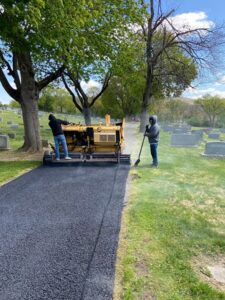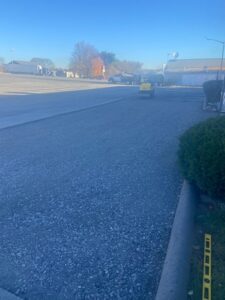- Sealcoating in hamburg Basics
Sealcoating is a process that involves applying a protective layer on the surface of asphalt to extend its lifespan and enhance its appearance. It acts as a shield, preventing water, oil, and other harmful substances from penetrating the asphalt and causing damage. By sealcoating your asphalt regularly, you can significantly reduce the likelihood of cracks, potholes, and other forms of deterioration.
Typically, sealcoating is done using either coal tar or asphalt-based products. These products are specifically designed to adhere to the surface of the asphalt, forming a durable and flexible layer. While both options have their advantages, coal tar sealants are often preferred due to their superior resistance to UV radiation and longer lifespan. However, local regulations may restrict the use of coal tar sealants due to potential environmental concerns. It is essential to familiarize yourself with the regulations in your area to ensure compliance.
The Importance of Sealcoating
Sealcoating plays a crucial role in the maintenance of asphalt surfaces. It acts as a protective layer, shielding the pavement from various elements that can cause deterioration. Over time, exposure to harsh weather conditions, sunlight, chemicals, and heavy traffic can lead to cracks, potholes, and other forms of damage. Sealcoating not only helps to prevent this damage but also extends the lifespan of the asphalt. By creating a barrier against these external factors, sealcoating helps to preserve the integrity of the pavement, reducing the need for costly repairs or replacements in the long run.
In addition to providing protection, sealcoating enhances the visual appeal of the asphalt. The application of a fresh sealcoat gives the pavement a smooth, jet-black finish that can revitalize the overall appearance of driveways, walkways, parking lots, and other asphalt surfaces. This can be particularly beneficial for businesses, as a well-maintained and aesthetically pleasing property creates a positive impression on customers and clients. By investing in regular sealcoating, property owners can not only maintain the structural integrity of their asphalt but also enhance the curb appeal of their premises.
Understanding Asphalt Deterioration
Asphalt deterioration is an inevitable process that occurs over time due to various factors such as weather conditions, heavy traffic, and insufficient maintenance. One of the primary causes of asphalt deterioration is the constant exposure to harsh elements, including UV rays, rain, and temperature fluctuations. The combination of these factors causes the asphalt to become brittle, leading to cracks, fissures, and potholes. Additionally, frequent heavy traffic can exacerbate the deterioration process as the weight and friction of vehicles gradually wear down the asphalt surface. It is crucial to understand these factors to effectively address asphalt deterioration and prolong the lifespan of your asphalt pavement.
Another contributing factor to asphalt deterioration is the lack of proper maintenance. Failure to implement routine inspections, repairs, and P can accelerate the deterioration process. Neglected or damaged areas of asphalt can quickly worsen, allowing water and other contaminants to penetrate the surface and undermine its integrity. As water seeps into cracks and potholes, it can further erode the underlying layers of the pavement, resulting in more extensive damage. Understanding the causes and consequences of asphalt deterioration is essential in implementing timely and proactive measures to protect and maintain your asphalt surfaces.
Signs That Your Asphalt Needs Sealcoating
Cracks and potholes are visual cues that your asphalt may be in need of sealcoating. Over time, the intense exposure to UV rays, moisture, and constant vehicle traffic can take its toll on the asphalt surface, causing it to deteriorate. As a result, cracks and potholes may start to appear, compromising the integrity and aesthetic appeal of your pavement. It is crucial to address these issues promptly to prevent further damage and costly repairs.
Another sign that your asphalt may require sealcoating is fading or dulling of the surface color. As asphalt ages, it can lose its original vibrant hue and become grayish or faded. This color change is mainly caused by oxidation from exposure to the elements. Sealcoating not only restores the rich black color of the asphalt but also protects it from oxidation, extending its lifespan. Regularly monitoring the color of your asphalt can help you determine when it is time to apply sealcoating to maintain its visual attractiveness.
• Cracks and potholes are visual cues that your asphalt may need sealcoating
• UV rays, moisture, and vehicle traffic can cause deterioration of the asphalt surface
• Promptly addressing cracks and potholes can prevent further damage and costly repairs
• Fading or dulling of the surface color is another sign that sealcoating may be necessary
• Asphalt can lose its vibrant hue and become grayish or faded over time due to oxidation
• Sealcoating restores the rich black color of the asphalt and protects it from oxidation
• Regularly monitoring the color of your asphalt can help determine when to apply sealcoating for visual attractiveness.

Sealcoating in hamburg
Choosing the Right Time for Sealcoating In Hamburg
Choosing the right time for sealcoating your asphalt surface is crucial for ensuring long-lasting protection and optimal results. Generally, it is recommended to schedule during the warmer months when the weather is dry and temperatures are consistently above 50 degrees Fahrenheit. This allows the
An important factor to consider when choosing the time for sealcoating is to avoid periods of heavy rainfall or high humidity. Moisture can impede the curing process and compromise the effectiveness of the Sealcoating in hamburg. Therefore, it is advisable to check the weather forecast and select a time when there is little to no chance of rain for at least 24 hours after the application. Additionally, allowing the asphalt to dry completely before and after sealcoating is vital, as any moisture trapped beneath the sealcoating can lead to issues such as bubbling and peeling.
Preparing Your Asphalt Surface for Sealcoating in hamburg
Before applying Sealcoating in hamburg to your asphalt surface, it is important to properly prepare it to ensure the best results. The first step in preparing your asphalt surface is to thoroughly clean it. This includes removing any debris such as dirt, leaves, and loose gravel. Use a broom or blower to sweep the surface, and consider using a pressure washer for a deeper clean. Removing these contaminants will allow the sealcoating to properly adhere to the surface and provide better protection against the elements.
Once the surface is clean, it may be necessary to repair any cracks or potholes before applying sealcoating. Fill in any cracks with a rubberized crack filler, making sure to follow the manufacturer’s instructions. For larger cracks or potholes, you may need to use an asphalt patching compound. Smooth out the patch or filler with a trowel or putty knife to ensure an even surface. Taking the time to repair these imperfections will help prevent further damage and extend the life of your asphalt.
Selecting the Right Sealcoating Product
When it comes to selecting the right sealcoating product for your asphalt, there are a few factors to consider. One important factor is the type of asphalt surface you have. Different Sealcoating in hamburg products are designed for different types of asphalt, such as residential driveways, commercial parking lots, or industrial surfaces. It’s crucial to choose a product that is specifically formulated for your type of asphalt to ensure optimal results.
Another consideration when selecting a sealcoating product is the level of protection you require. Some products offer basic protection against elements like UV rays and water damage, while others provide more advanced protection against heavy traffic and chemical spills. Assessing the specific needs of your asphalt surface will help you determine the level of protection necessary and guide you in selecting the appropriate sealcoating product.
Remember, choosing the right Sealcoating in hamburg in hamburg product is essential for the longevity and appearance of your asphalt surface. Take the time to research and understand the specific requirements of your project to make an informed decision that will result in a durable and long-lasting sealcoating application.
Applying Sealcoating in hamburg Properly
Proper application of sealcoating is essential for maximizing its effectiveness and longevity. To ensure a successful Sealcoating in hamburg job, there are a few key steps that should be followed. Firstly, it is important to thoroughly clean the asphalt surface before applying the sealcoat. This involves removing any debris, dirt, or oil stains that may hinder the adhesion of the sealcoat. Pressure washing or using a scrub brush and detergent can be effective in achieving a clean surface. Secondly, any existing cracks or potholes should be repaired prior to Sealcoating in hamburg. Filling these imperfections with a suitable crack filler will help create a smooth and uniform surface, ensuring proper sealcoat adhesion. Once the surface is clean and repaired, the sealcoat can be applied using a squeegee, brush, or sprayer, depending on the size of the job and personal preference. It is crucial to evenly and uniformly spread the sealcoat, avoiding excess buildup in certain areas. This will promote a consistent protective layer and improve the overall appearance of the asphalt.
What is Sealcoating in hamburg?
Sealcoating in hamburg is a process of applying a protective coating to asphalt surfaces to prolong their lifespan and prevent deterioration.
Why is sealcoating important?
Sealcoating in hamburg helps to protect asphalt surfaces from various elements such as UV rays, water, chemicals, and traffic. It also enhances the appearance of the pavement and reduces the need for costly repairs.
How does asphalt deteriorate?
Asphalt deteriorates due to exposure to sunlight, water, oil, and other chemicals. Over time, this causes the asphalt to become brittle, faded, and develop cracks and potholes.
What are some signs that my asphalt needs sealcoating in Hamburg?
Signs that your asphalt needs Sealcoating in hamburg include fading color, the presence of cracks or potholes, rough texture, and signs of water damage.
When is the right time to apply sealcoating?
It is recommended to apply Sealcoating in hamburg when the weather is dry and temperatures are above 50°F (10°C). Spring or early fall are often considered the best times for sealcoating.
How should I prepare my asphalt surface for sealcoating?
Before Sealcoating in hamburg, you should clean the surface thoroughly by removing any debris, dirt, or vegetation. Fill any cracks or potholes and let them dry completely.
How do I select the right sealcoating product?
The right sealcoatin in hamburg product depends on various factors such as the condition of your asphalt, traffic volume, climate, and budget. Consult with a professional or supplier to determine the best product for your specific needs.
How do I apply sealcoating properly?
To apply Sealcoating in hamburg properly, start by edging the area with a brush or edge sealer. Then, use a squeegee or sprayer to apply the sealcoat evenly. Follow the manufacturer’s instructions for drying and curing times.


